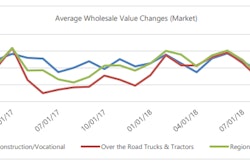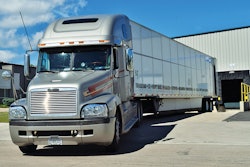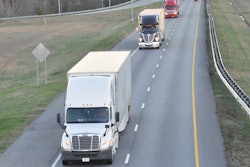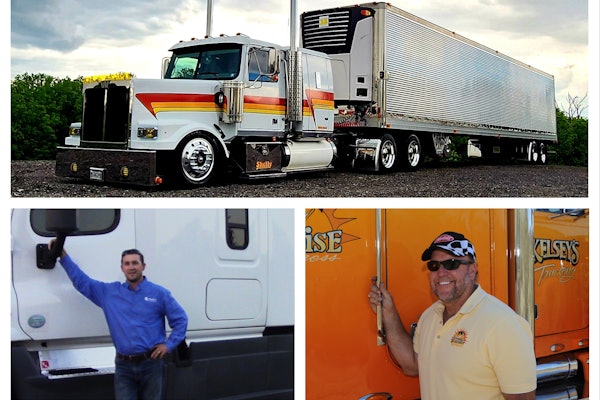PARTNERS IN BUSINESS TABLE OF CONTENTS »
Determine your best method for acquiring a truck
It’s no secret that affording a new tractor has become more complicated for owner-operators and many smaller carriers over the past decade as equipment costs have risen dramatically. Nonetheless, as acquisition patterns change, one of the most basic decisions you need to make remains the same: whether to buy or lease. Each option has advantages and drawbacks.
PURCHASING. When you take out a loan and arrange to finance a truck, you are buying the vehicle and will own it at the end of the contract. A loan requires monthly payments, usually over four to seven years for new power units. Your monthly payments include principal and interest. With many finance contracts, you pay more interest per payment in the early years, and pay down more of the principal per payment in the later years.
LEASING. Leasing is similar to renting. You pay for the use of a truck that is not actually yours. When the lease is up — usually in three to five years — you do not own the truck as you would if it were financed; you return it to the lease company. However, you can elect to purchase the truck at a predetermined price. This residual value of the truck is often agreed upon in the original lease document. Leasing models can vary greatly and differ from buying through a carrier’s lease-purchase plan.

Traditionally, few owner-operators take this route toward acquiring equipment, though there’s evidence that with the rising cost of new trucks, it’s becoming more common. Maintenance contracts included as part of the deal, where the leasing company assumes responsibility for most maintenance, could be good insurance against emissions-system issues seen in 2007 and later model-year diesels.
DEFINE YOUR BUSINESS
Most potential owner-operators wouldn’t dream of going to a carrier without already having a truck. Any reputable carrier representative will be eager to talk with you and help you understand his operation before you own the truck. As you talk with potential carriers, further outline your business model. This is a great opportunity to spec the right truck for the work you are planning.
Before talking with a sales representative about buying or leasing, make sure you can answer a few key questions:
- Does the carrier have tractor restrictions that will affect your purchase? Some companies won’t use trucks that are beyond a certain age, or may require additional items such as a headache rack.
- What fees apply to you as an owner-operator? Are you required to buy base plates at startup? Does your carrier require additional purchases, such as an onboard communications system? When are these required?
- How much will you need as a down payment for insurance?
- What are you being paid per mile or percentage, and what are the average miles per month you can expect to run? Dispatchers and other owner-operators may be more candid than other company representatives. See Chapter 13 for more on choosing a carrier.
FINANCING YOUR EQUIPMENT
Financing a truck can be frustrating, confusing and time-consuming, especially for first-time buyers. It also can be costly if you are not prepared. The more deliberate you are about this process, the better your position. Give yourself plenty of time to shop for a truck and for favorable financing. Visit dealers and ask questions. Know what risk you present for a potential lender.
The good news is that truck loans, like business loans from a bank, usually have much lower rates than credit cards. Loans for trucks and other secured loans, such as cars or houses, are lowest because assets are backing them up. A bank’s business loan often is about 1 percent a month or 12 percent annually, though good-credit borrowers in recent years have seen rates as low at 5 percent on truck loans.
Get a copy of your credit report before you attempt to secure equipment financing. Your credit history could contain wrong or harmful information that you’ll want to explain to a potential lender. Always be upfront about your problems. Showing you have overcome hard times demonstrates determination and strong character.
When you apply for a loan, be prepared to provide as much information as you can. Show the lender you are a business owner first and a truck operator second.
You’ll need a budget, a cash-flow statement and a business plan.
A detailed budget will assure the lender you can meet the financial obligations of owning a truck. A cash-flow statement shows your projected revenue will be sufficient to meet current obligations. A business plan outlines the details of your operation, including the types of freight you’ll haul, the traffic lanes you’ll run and the rate you’ll be paid. It also lists the name, address and telephone number of the company to which you plan to lease, as well as a contact name to verify that lease.
If you plan to run independently, you’ll need to list contact information for your customers. Bring your lender a list of credit references, even if you don’t have a perfect credit history. Include present and past creditors.
FINANCING SOURCES
There are multiple options for borrowing money. Check around for the lender that best suits your needs.
BANKS. Banks are reluctant to lend money for an over-the-road truck. In their opinion, “rolling collateral” is not a good risk. If you’ve been doing business at the same bank for a long time, however, and have an established relationship with a loan officer, it could be worth taking this route if your credit is good.
CAPTIVE LENDING INSTITUTIONS. These finance companies are owned by equipment manufacturers. They often are more willing than banks to lend money to new owner-operators because they are in the business of selling trucks.
USED TRUCK DEALERS. Your dealer may refer you to lenders other than captive finance arms.
COMMERCIAL LENDING INSTITUTIONS. These finance companies are not necessarily affiliated with truck manufacturers, but certain ones cater to the trucking industry.
GETTING THE MONEY
The cost of borrowing is generally low right now, so with good credit, you should be able to get a good loan. With an “A” credit score above 700, a borrower often can get a loan for 5 or 6 percent. A “B” credit score between 650 and 700 will be around 7 to 9 percent, and a “C” score between 600 and 650 will be around 9 percent to the low teens. A credit score much lower than 600 might make it difficult to get a loan right off.
Whatever type of financing you choose, keep in mind that truck loan interest rates can vary by two or three percentage points from lender to lender, or even more – a potential difference of thousands of dollars in interest costs over the life of a loan.
No matter where you obtain financing, the following can affect your interest rate:
- Credit history. People who have good credit get the lowest interest rates.
- Stable job history. Job-hopping indicates a lack of responsibility and rings the alarm for a lender.
- Longtime residency. People who live at the same address for a long time usually have a better credit rating.
Don’t take the first financing option you’re offered. You can negotiate loan rates just as you can haggle over the price of a truck or the rate on a load. Interest rates vary because of many factors, and finance managers have some leeway when setting a rate for you.
TWEAKING THE LOAN
Some finance companies offer creative solutions for particular situations. These options include:
Variable rates. Most truck loans have a fixed interest rate, which means that you pay the same rate throughout the term of the loan. Sometimes you can get a variable rate. This usually is a good deal if prime rates hold steady or drop, but if rates go up too much for too long, you might end up paying more than you would have under a fixed-rate loan.
More principal up front. With this option, your monthly interest charges and payments decline over time. Having lower payments in the latter part of the loan helps in two ways: It gives you more cash for truck maintenance as the truck ages, and it allows you to save for your next down payment as the time to trade approaches.
Skip-payment plan. Designed for truckers with seasonal freight, this plan allows you to miss a payment or two during slow times. You make the arrangements at the time of purchase. A variation is an extension of the first payment, say to 45 days, something many lenders are willing to do if your credit is strong.
Programs for buyers low on cash or credit. Some owner-operators without the cash for a big down payment or access to favorable loans have seen success buying in carrier sales programs for used fleet trucks. Unlike many lease-purchases in such programs, buyers do not have to be affiliated with the carrier.
A shorter loan period. This means higher payments but big savings in interest. If you’re used to 72-month loans — the owner-operator’s favorite — try to make a 48-month deal work.
Qualifying for a good rate. Big contributing factors to interest rates are how much you put down, the type of truck you buy, your credit score and your loan-to-truck value ratio.
For owner-operators with good credit and who have a sizable down payment, local banks can offer rates below 10 percent. Those with credit issues could see rates higher than credit card rates.
Though some owner-operators may find it difficult to get financing, lenders today are much more willing to work with used truck buyers than in recent, tougher years. The upturn in freight over the three to four years preceding 2016 brought many lenders back into the business.
While the price of trucks continued to get higher, the ability to make an economic return with that investment was there. At the same time, high-mileage trucks make lenders more hesitant, and they’ll also want decent down payments, often around 20 percent.
First-time buyers could see interest rates of 18 to 20 percent, and first-time buyers and buyers with credit problems should be wary of service charges that could add $1,000 or more to monthly payments.
Many lenders are using past credit scores to “dig deeper” into buyers’ credit profiles in today’s market. Yearly earnings, business longevity, how long you’ve had a commercial driver’s license, a recent home foreclosure or truck repossession, and items that show up on public records all have a bearing on your financing.
Meeting debt obligations and saving for a 25 percent down payment should open the door for a first-time buyer’s financing. Those buyers also do well if they have three to four accident-free years in trucking.
LEASE-PURCHASE PLANS
Lease-purchase plans are somewhat well-used paths to truck ownership, particularly among operators with otherwise shaky credit, but Overdrive surveys of recent history have shown fewer than a fourth of all owner-operators purchasing trucks this way. Carrier lease-purchase programs generate the most controversy for practices that favor the company at the owner-operator’s expense.
Common complaints include abnormally high weekly payments, mileage reduction toward the end of the contract, undisclosed fees and charges, and the inability to transfer the leasing arrangement to another carrier. But some carriers live up to the commonly expressed intention of developing an owner-operator base and helping contractors develop their businesses.
If you have questions after reading the contract, consider hiring a lawyer or financial adviser to review it. Make sure items such as down payment, weekly or monthly payments, maintenance escrow account, length of contract and what you’ll owe at the end of the agreement are spelled out.
Work up a budget to get an idea of what truck payments you can afford and how much revenue you’ll need to cover payments and other financial obligations. Given the age of the truck, estimate what it will be worth when you complete the contract.
Many carriers offer no-money-down contracts, but this often means higher periodic payments. Be alert to the amount of any balloon payment at the contract’s end and how you’re going to save for it.
The terminal rental adjustment clause (TRAC) lease, the basic form of the lease-purchase, is intended to allow shared responsibility between the lessee and lessor.
It gives the owner-operator the right of ownership at the lease’s end while reducing cash outlays over that term. The operator can choose to pay the residual, or balloon, at the term’s end or opt to take whatever equity he or she may have — if the truck is worth more than the residual amount owed — and move into a different truck, using the equity as a down payment. Secured directly with a dealer’s finance department, a TRAC lease generally will be available only to those with better credit than is required of a traditional loan in today’s world.
ESTIMATE TRUE COSTS. Calculating the total cost of a truck under a lease-purchase plan can be difficult. It’s easy to hide the amount of interest in vehicle leases. Beyond knowing the monthly lease payment, make sure you know the total purchase price. The cost of interest isn’t the only factor. Given the price and condition of a truck at the beginning of the lease, you should make an informed estimate of what it will be worth by the time you take ownership. Otherwise, you run the risk of having little equity to put toward your first trade. Some buyers have come to final payment only to find the truck is worth less than the amount owed.
COMPARE LEASE-PURCHASE PROGRAMS. If you haven’t been with a company long, establish trust with management and learn the details of the operation. Once you understand your company’s lease-purchase program, call other carriers and compare their programs.
RESEARCH YOUR COMPANY’S FINANCIAL STABILITY. Most lease-purchase programs tie you to the company until the end of the lease, so the company’s health could impact your ability to complete the lease. If the company is publicly traded, its financial picture is available online and elsewhere. If it’s private, don’t be afraid to ask about its long-term financial prospects and debt level. Learn about its reputation within the industry.
Research the economic outlook for its primary shippers. A downturn in freight could reduce your miles and destroy the chance of completing your lease.
CHECK OUT THE TRUCK YOU INTEND TO LEASE. Ask to see maintenance records, and inquire about any major repairs. Make sure all recalls have been addressed and problems fixed. If warranties are offered, study the terms.
Ask how many times the truck has been leased. This not only will give you insight into the equipment itself, but also the lease-purchase program. Numerous leases on a particular truck should be a red flag.
BE PREPARED FOR THE PAYOFF. In the case of an end-of-lease balloon payment, devise a financial plan that will ensure you can make that final payment. Calculate what you will owe compared to the truck’s estimated actual value at that point. You don’t want to be underwater at the end of the lease – owing more than the truck is worth. Nor do you want to make payments for years and have little or no equity because you can’t make that final payment.
UNDERSTAND ESCROW ACCOUNTS. A maintenance escrow (also see Chapter 12) can be helpful if you are inexperienced with a truck’s upkeep and saving money, but some lease-purchase escrows give limited or no control over your use of the funds. There might be a minimum balance requirement that forces you to pay out of pocket for a repair.
Other escrow accounts can be required, such as a security escrow to cover expenses the lessee fails to pay. So make sure that you can get the escrow balances back when you complete the lease or if you change carriers.
ASK QUESTIONS. If you’re thinking about a lease-purchase plan, ask the carrier:
- What happens if I want to change carriers?
- Is there a penalty for early payoff?
- Will an accurate account of payment show up in every settlement?
- Will I be able to show a profit after payments are deducted?
- How long before I own the truck?
- What percentage of lease-purchase participants in your plan eventually take ownership of their tractors?
CLEANING YOUR CREDIT
Bad credit adds tens of thousands of dollars to the price of a truck or a house by increasing the cost of borrowing money. During the late-2008 credit crunch, lending terms tightened, though they’ve loosened recently. However, having good credit continues to be important and pays off in much better rates than what bad-credit borrowers are forced to accept.
An owner-operator with bad credit may get turned down by the fleet to which he hoped to lease. He may get turned down by a government agency when he applies for a loan to purchase a low-cost anti-idling kit. Lucrative military or otherwise sensitive freight might never go onto his truck because the Pentagon or other shippers don’t consider him a good risk.
Keep in mind that for a self-employed person such as an owner-operator, personal credit and business credit are indistinguishable. Self-employed people sometimes want to show a loss at year’s end for tax purposes, but that negative net income looks bad to a lender.
When you seek financing from a truck manufacturer, your local bank or any other lender, you can try to make clear to the loan officer the distinction between your business finances and your personal finances. Credit bureaus, however, don’t make that distinction; they just crunch the numbers to determine your credit rating.
Here’s a breakdown for how your credit score is calculated:
- Your payment history: 35 percent.
- Outstanding debt: 30 percent.
- The length of your credit history: 15 percent.
- The types of credit you use: 10 percent.
- The new credit you request: 10 percent.
The good news is that even the worst credit situation can be improved. As little as two or three years of good payment behavior can make a positive difference in your credit score, which assigns more weight to recent acts than to older ones. In the meantime, lenders are out there for truck buyers even with C-level and D-level credit, especially in the used-truck market. And certain carriers always are looking to groom owner-operators, providing bookkeeping and business advice to help those clients succeed.
In the general lending market, those with a credit score in the low 600s probably can find a lender but likely will have to put down 20 percent or more as opposed to the traditional 10 or 15 percent. Buyers with a credit score in the 500s, on the other hand, may be out of luck outside of a lease-purchase arrangement – at least temporarily.
The Used Truck Association recommends this three-step process for climbing out of a bad-credit hole:
1. Be willing to start with a cheap used truck, coupled with a strong maintenance savings plan.
2. Bite the bullet on interest rates. You might pay 18 or 20 percent interest, but on a $20,000 truck, that means only an extra $30 to $40 a month.
3. Work on improving your credit rating and qualifying to refinance the loan at a better rate in a year or two.
There are many ways to improve your credit rating, though it takes time. The obvious ones include:
• If you’re in arrears on any accounts, pay what you owe — including penalties — as fast as possible, even if it means living off Ramen noodles.
• Pay bills, including all personal bills, on time. Often this means making a business budget and a household budget and sticking to them.
• Reduce your credit card balances. The ideal is to pay off each one monthly to avoid interest, but even if you can’t manage that just yet, pay them down until each balance is no more than half the card limit.
• Consolidating your credit card debt onto one card can be worthwhile, but only if you can find a card that will enable you to do that without costing you more in the long run. MyFICO.com offers a free online calculator that can show you whether such an offer really is a good deal.
• Avoid signing up for new cards. The average American makes fewer than two credit applications a year, so if you do even three in a given year, you’re hurting your credit score. Your ideal ratio should be one credit card for each installment loan, up to five cards. That means your truck loan “earns” you one credit card, your mortgage a second credit card and so on.
• On the other hand, if you have an old credit card that you barely use anymore, don’t be too quick to close it out. Its mere existence provides a boost to your credit score, 15 percent of which depends on the length of your credit history – or, in other words, how long you’ve been someone’s good customer.
• Don’t co-sign a loan, even if you’re trying to help out a close friend or relative. In many states, if the primary borrower misses payments, the creditors can turn to the co-signer for satisfaction. You could lose your truck – even your house.
• Use what you save. Once you’re current on your truck and mortgage payments and have paid off your credit card debt, you’ll have extra money each month that’s no longer being spent on interest and penalties. Put this “found money” into your emergency fund or your retirement savings, or invest it.
Download the entire Partners in Business Manual
Chapter 1: Becoming your own boss
Chapter 2: Bookkeeping and business analysis
Chapter 3: Understanding your revenue and costs
Chapter 5: Controlling fuel costs
Chapter 6: Controlling tire costs
Chapter 8: Income tax and other taxes
Chapter 9: Choosing a business structure
Chapter 10: Truck buying, leasing, financing
Chapter 11: Choosing a trailer
Chapter 12: Maintaining your equipment
Chapter 13: Choosing a carrier
Chapter 14: Computers, mobile devices and the internet
Chapter 15: Staying compliant and safe
Chapter 16: Trucking insurance











